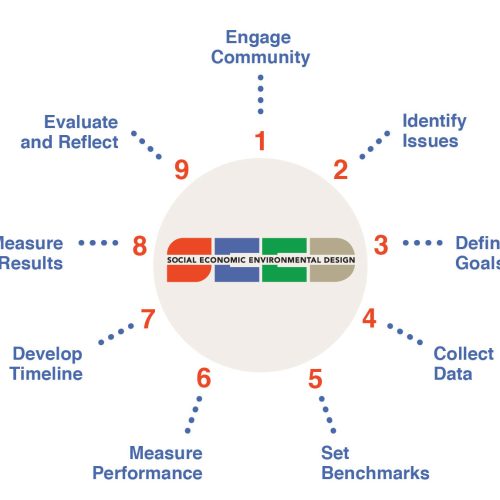Five SEED Principles
- Advocate with those who have a limited voice in public life
- Build structures for inclusion that engage stakeholders and allow communities to make decisions
- Promote social equality through discourse that reflects a range of values and social identities
- Generate ideas that grow from place and build local capacity
- Design to help conserve resources and minimize waste
A Word about Research
The SEED Network offers the SEED Evaluator tool as methodology for pursuing a participatory design process that activates a range of voices affected in a project. The SEED Evaluator provides a common standard to guide, measure, evaluate and certify the social, economic and environmental impact of design projects. Acting on its name, the SEED Evaluator promotes the critical evaluation of design that strives for positive impact. Managed through an integrated software platform at www.seednetwork.org, the SEED Evaluator promotes communication between design teams and communities by providing a mechanism to document decision-making, participatory processes, community identified goals, and project results. The benefits of the SEED Evaluator include assessment of project process and results through a third-party review, which may lead to project certification, SEED Certification.The SEED Evaluator can help project teams and their community’s direct like-minded goals. Because the SEED Network promotes defining goals based on triple bottom line considerations of social justice, economic development, and environmental conservation, teams discover they can address multiple issues with a project. Putting emphasis on stakeholder inclusion in the design process can empower communities to develop project-specific leadership, which can impact outcomes. The SEED Evaluator acknowledges:
- How the project creates positive change in the face of social, economic and environmental challenges;
- How the design product answers the short and long term needs of a community while validating ethical and sustainable approaches to design;
- How the design team engages stakeholders in the total project process so that the outcome is informed from the ground up.
How does it work? The SEED Evaluator offers a guided approach broken down into practical steps in phases—Part 1, 2, and 3—that correlate to project conception, iterative development, SEED® Evaluator 3.0 Instructional Overview 2 and outcomes. Exemplary evidence within the three parts of the SEED Evaluator can lead to a project being awarded SEED Certification. SEED Certification is the standard teams and communities seek when addressing complex issues and especially those of social equity. A tool easily adaptable to teams across the spectrum of design practice, the SEED Evaluator promotes examination of project viability through each phase of development while keeping an eye to a bottom-up approach that activates community concerns though engagement.
Regardless of what specific strategies are used (many of which can be adopted from the participation tactics list on pages 322–5 in the Public Interest Design Practice Guidebook), collaboration as a mechanism for research should be embedded within the public interest designer’s process. Research conducted through a framework of extended engagement reasserts the need to understand the impact of the work in various phases of implementation. Performance measurement and documentation gathered through a defined research process, which includes qualitative and quantitative methods, supports this goal.Qualitative research helps define the nature of a design problem and is open to descriptive variables that may be subjective. Research methods can include observations and flexible or semi-structured interviews—the format for recording information can involve audio, visual, and written documentation (e.g., field notes, visual mapping, sound or photographic recordings, to name a few).
Quantitative research is not very flexible, as it relies on collected data to establish meaningful connections through numeric-assessment methods provided in predetermined controls. Patterns, categorizations, and statistical outcomes are typical results, which can be used to help answer questions.The SEED process supports a balanced and informed research and data-collection process in order to reveal community voice through collaboration. The method used and the data gathered, as well as participating individuals or groups, should be clearly documented so that community or audience context is understood by all involved in the project. Research does not need to be logistically difficult, expensive, or time consuming; however, research supports the understanding of the nature or context of the problem and thereby provides a platform on which to build collaboration. Stakeholder observations, discussion groups, and informal community gatherings can qualify as forms of research, so consider the possible scope of relevant methods.

